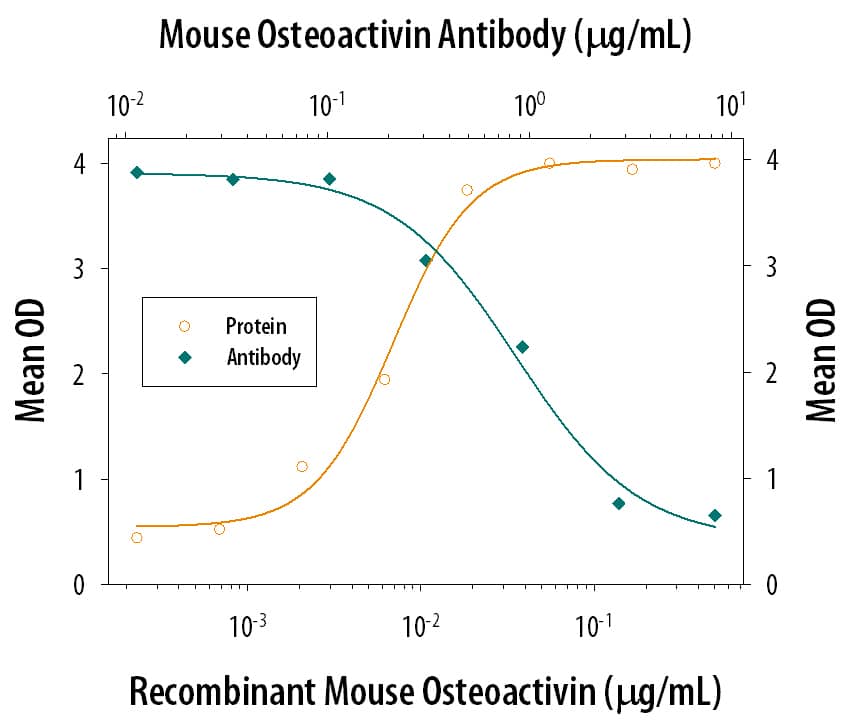Mouse Osteoactivin/GPNMB Antibody
R&D Systems, part of Bio-Techne | Catalog # AF2330


Key Product Details
Species Reactivity
Validated:
Cited:
Applications
Validated:
Cited:
Label
Antibody Source
Product Specifications
Immunogen
Lys23-Asn502
Accession # Q8BVA0
Specificity
Clonality
Host
Isotype
Endotoxin Level
Scientific Data Images for Mouse Osteoactivin/GPNMB Antibody
Cell Adhesion Mediated by Osteoactivin/GPNMB and Neutralization by Mouse Osteoactivin/GPNMB Antibody.
Recombinant Mouse Osteoactivin/GPNMB Fc Chimera (Catalog # 2330-AC), immobilized onto a microplate previously coated with Goat Anti-Mouse IgG Fc (Catalog # G-202-C), supports the adhesion of the SVEC4-10 mouse vascular endothelial cell line in a dose-dependent manner (orange line), as measured by endogenous cellular lysosomal acid phosphatase activity. Adhesion elicited by Recombinant Mouse Osteoactivin/GPNMB Fc Chimera (0.25 µg/mL) is neutralized (green line) by increasing concentrations of Goat Anti-Mouse Osteoactivin/ GPNMB Antigen Affinity-purified Polyclonal Antibody (Catalog # AF2330). The ND50 is typically 0.2-0.8 µg/mL.Detection of Human Osteoactivin/GPNMB by Western Blot
GPNMB and galectin-3 levels are elevated in FTD-GRN brains. a, b GPNMB and galectin-3 levels (ng/mg protein) were measured in frontal lobe tissue lysates generated from cognitively normal controls (CTL; n = 27) and FTD-GRN patients (n = 25). Data analyzed using unpaired t-test. c Representative immunoblots for GPNMB and galectin-3 in frontal lobe lysates from cognitively normal controls (n = 8) and FTD-GRN (n = 8) patients. d GPNMB levels (ng/mL) in CSF samples form cognitively normal controls (n = 14), FTD-GRN (n = 9), FTD-C9orf72 (n = 12) and FTD-MAPT (n = 12) samples quantified by ELISA. Data analyzed using one-way ANOVA. e, f GPNMB immunostaining was performed on frontal lobe tissue sections from cognitively normal controls (n = 5) (e) and FTD-GRN (n = 5) (f) patients. g, h Immunostaining for p-TDP 43 was stained on adjacent sections from identical samples in e, f as marker of FTLD pathology. i GPNMB staining intensity in human brain sections (e, f) were measured and presented as fold change. Representative immunofluorescence staining for cell markers (green) (j, n, r), GPNMB (red) (k, o, s), DAPI (blue) (i, p, t) in paraffin sections of brains from FTD-GRN cases. Iba-1, GFAP, NeuN used for markers of human microglia, astrocytes, and neurons respectively. GPNMB and Iba-1 signals overlap (arrow) (m) whereas, no overlapping signal was observed in co-staining with GFAP or NeuN (q, u). Scale bars were labeled in the images. Data analyzed by unpaired t-test. Scale bars (20 µm) labeled in images and quantitative data are shown as mean ± SEM, *p < 0.05; **p < 0.01; ***p < 0.001; ****p < 0.0001 Image collected and cropped by CiteAb from the following open publication (https://pubmed.ncbi.nlm.nih.gov/33028409), licensed under a CC-BY license. Not internally tested by R&D Systems.Detection of Mouse Osteoactivin/GPNMB by Immunohistochemistry
GPNMB and galectin-3 co-localize with Iba-1 positive microglia cells in Grn−/− mouse brain. a Representative immunofluorescent co-staining for different cell markers (Iba-1, microglia; GFAP, astrocytes; NeuN, neurons) are shown in green, GPNMB (red), and nuclei (DAPI; blue) in brains of 19-month-old Grn−/− mice. b Representative immunofluorescent co-staining for different cell markers (Iba-1, microglia; GFAP, astrocytes; NeuN, neurons) are shown in green, galectin-3 (red), and nuclei (DAPI; blue) in brains of 19-month-old Grn−/− mice. Scale bars (20 µm) labeled in images Image collected and cropped by CiteAb from the following open publication (https://pubmed.ncbi.nlm.nih.gov/33028409), licensed under a CC-BY license. Not internally tested by R&D Systems.Applications for Mouse Osteoactivin/GPNMB Antibody
Western Blot
Sample: Recombinant Mouse Osteoactivin/GPNMB Fc Chimera (Catalog # 2330-AC)
Neutralization
Mouse Osteoactivin/GPNMB Sandwich Immunoassay
Reviewed Applications
Read 2 reviews rated 4.5 using AF2330 in the following applications:
Formulation, Preparation, and Storage
Purification
Reconstitution
Formulation
Shipping
Stability & Storage
- 12 months from date of receipt, -20 to -70 °C as supplied.
- 1 month, 2 to 8 °C under sterile conditions after reconstitution.
- 6 months, -20 to -70 °C under sterile conditions after reconstitution.
Background: Osteoactivin/GPNMB
Osteoactivin (also named GPNMB and DC-HIL) is a 125 kDa, intracellular glycoprotein that is associated with cell endosomal/lysosomal compartments (1, 2). Mouse osteoactivin is synthesized as a type I, transmembrane, 574 amino acid (aa) precursor that contains a 22 aa signal sequence, a 478 aa luminal/extracellular domain, a 23 aa transmembrane segment and a 51 aa cytoplasmic tail. The luminal region contains an N-terminal heparin-binding motif, multiple glycosylation sites, an RGD motif and a 130 aa PKD domain. The intracellular tail also has an RGD motif, plus an ITAM (Y-x-x-I) and lysosomal targeting (L-L) motif. The extracellular/luminal region is 89% and 74% aa identical to the equivalent regions in rat and human, respectively. Cells known to express osteoactivin include osteoblasts, dendritic cells, and melanocytes, plus fetal chondrocytes and stratum basale keratinocytes (2, 3). Osteoactivin is reported to bind to heparan sulfate-proteoglycan, possibly on the surface of fibroblasts and endothelial cells (2). It may also interact with integrins.
References
- Bachner, D. et al. (2002) Gene Exp. Patterns 1:159.
- Shikano, S. et al. (2001) J. Biol. Chem. 276:8125.
- Owen, T.A. et al. (2003) Crit. Rev. Eukaryot. Gene Expr. 13:205.
Long Name
Alternate Names
Gene Symbol
UniProt
Additional Osteoactivin/GPNMB Products
Product Documents for Mouse Osteoactivin/GPNMB Antibody
Product Specific Notices for Mouse Osteoactivin/GPNMB Antibody
For research use only

